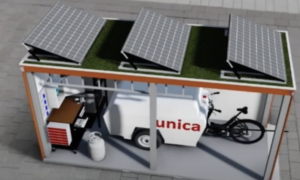Maintenance of buildings leads to many service van movements. From 2025, 40 Dutch municipalities will implement zero-emission zones. One of these cities is Amsterdam. Amsterdam also opts for car-free residential areas, campuses, and business parks. What are the threats and opportunities for service logistics?
What measures should you take today?
On 22 September, the Amsterdam Cumulus Park Studio organized an online roundtable about making service logistics more sustainable. What are the threats and opportunities? In a sector working for clean energy, smart meters, heat pumps, solar panels, and charging infrastructure, the good old diesel van is not okay anymore. Business operations have to change when working with an electric van. The Gas Op Elektrisch project of the Hogeschool van Amsterdam provides many lessons learned.
The first question is what is the right vehicle for zero-emissions zones. It is not smart to exchange the diesel delivery van for an electric one out of habit. Consider the use of light electric vehicles, such as cargo bikes. Range and payload are potential obstacles. The service van should be put on a diet; travel light. Or can the engineer work entirely without a vehicle, by a different set-up of the supply of materials?
You have to drive smarter. The engineer determines the success of the introduction of the electric van. Driving style and route choice influence the range of the vehicle. The modern vehicles have onboard computers that monitor vehicle performance, the status of the trip, the battery status, and the driving style of the driver. With a short-range and long recharging time, dynamic planning is essential. Together with up-to-date traffic information, good service planning should be made for the reliable deployment of the van and the engineer. Then he or she is also on time with the customer. What does the engineer himself think of today’s planning?
You need to provide smart charging infrastructure. Most vans are parked at the engineer’s house at night and at the customer’s location during the day. Are there enough charging points there? Is there enough power supply? How does the engineer find his way to an available charging point? For business parks where many vehicles need to charge, a vision on smart charging is needed; smart and shared charging of vehicles overnight. There are opportunities here for service providers to offer new energy services; practice (and sell) what you preach.
Electricity is all but free. Diesel can be bought at any pump for the same price per liter. With electricity this is different. The prices at the charging points vary widely and are anything but transparent, especially for fast charging. Then electricity is more expensive than diesel. Fleet managers have to buy energy services smartly.
A ‘new task’ for buyers
In zero-emission projects, conversations between buyers and sellers of vehicles often get bogged down in a Babylonian confusion of speech. The purchase of vehicles is no longer a straight rebuy; neither is sales. On both sides of the table, there is a lack of knowledge to make the zero-emission service logistics challenge affordable and reliably available. Nor is it a ‘modified rebuy’. There is much more to it than that. This is a ‘new task’ for buyers. During the first projects, service companies and their mobility-as-a-service providers understand each other better and better. Together they can learn a lot, learn fast and, and frequently make adjustments. You can work it out.
Collaboration in service logistics?
Thinking about the fleet of the future also raises questions about how companies can innovate service logistics. Perhaps the one-to-one replacement of the diesel van is the right answer. Sometimes a light electric vehicle.
It is even more challenging to think about a ‘customer intimate’ service logistics future with more cooperation between service companies, asset management using BiM data, the deployment of IoT, telemaintenance, performance-based service logistics, and a smart network of local stock points. And, perhaps it’s swearing in the church, can we make customers more self-resilient?
Zero-emission transport invites us to take a new look at our service logistics together with clients, knowledge institutes, asset and facility managers, service companies, and their service providers. Don’t forget the engineer! What does he or she think about it all?
Walther Ploos van Amstel
Amsterdam University of Applied Sciences

